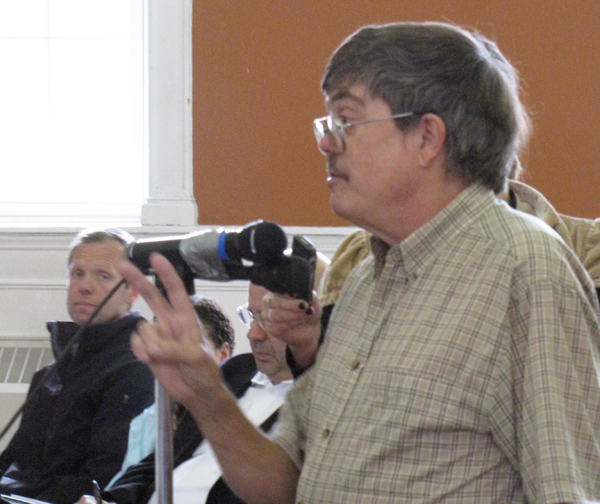By David Scribner
GREAT BARRINGTON – The first session to protest the creation of three toxic waste dumps in South County drew a packed audience to the First Congregational this week. The protesters were demanding that General Electric abandon its scheme to deposit in three proposed landfills the millions of cubic yards of PCB-laced sludge the company may be compelled to remove from the Housatonic River.
One of those dumps is along the west bank of Rising Pond where 44 acres would contain 2.9 million cubic yards of contaminated material removed from a highly toxic seam of PCBs in Rising Pond.
In October, GE released a 1,200-page “Corrective Measures Study” that detailed how the company would remove the polychlorinated biphenyls (PCB), a probable carcinogenic, embedded in riverbed sediment, the consequence of decades of contamination the company allowed to spill from its Pittsfield transformer manufacturing complex.
Until Dec. 11, the EPA is taking public commentary on the GE proposal, and early next year will begin its own review of the GE plan and then determine what features of the GE proposal it can accept – if any.
The now abandoned but contaminated Pittsfield factory site through which the river flows became one of the largest brownfields projects in New England. Through a 1997 agreement between GE and the Environmental Protection Agency, the company cleaned up a half-mile of river in Pittsfield, at a cost of hundreds of millions of dollars, but left the cleanup of what is euphemistically termed “the rest of the river” to be determined later.
Rather than transport the contaminated material by rail to a remediation site in Texas, as recommended by the EPA, GE’s study proposes landfilling the pollution on sites adjacent to the river. The company has already purchased the land for such landfills. The one in Lee is on Forest Street, just below Goose Pond; the location in Lenox is at Woods Pond.
Phyllis Skaller of Housatonic, one of the organizers of this week’s protest meeting, notes that the environmental danger is real enough that she would be willing to engage in civil disobedience to prevent the dumping of carcinogens in a landfill in Housatonic along the scenic Rising Pond.
“People have got to think beyond whether it’s in their own backyards,” she has said. “If these dumps happen, the contamination will be in everybody’s backyard.”
Tim Gray of the Housatonic River Initiative, who presented documentation about GE’s persistent denial of the dangers of PCBs, pointed out that the company would prefer “natural monitored recovery,” another way of saying that the PCBs should be left in the river.

“In essence, GE is saying we just don’t care what you think about PCB’s,” Gray said. “This is another part of GE’s long history of denial that they polluted the river when they dumped millions of pounds of PCBs into the river. They are saying that there’s nothing wrong with PCBs, just leave them where they are.”
He notes that GE employed the same tactics in communities in eastern New York where PCBs from it Ft. Edward factory had been dumped into the Hudson River. GE had recommended local landfills but was eventually forced to ship the PCB-polluted to a toxic waste disposal site.
Mickey Friedman, a veteran environmental activist, observed that there is millions of dollars at stake for GE in the method eventually chosen to remove contamination from the meandering Housatonic.
“Everything GE is doing with it proposal is designed to scare people into imagining the worst kind of cleanup,” he said. “GE know there are environmentally sensitive ways to remove PCBs. But GE is not to be believed. PCBs are terribly toxic. Only a careful and complete cleanup will keep wildlife and people safe.”
